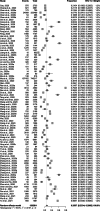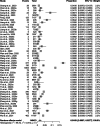Prevalence of depressive symptoms among Chinese university students amid the COVID-19 pandemic: a systematic review and meta-analysis
- PMID: 33766163
- PMCID: PMC8047400
- DOI: 10.1017/S2045796021000202
Prevalence of depressive symptoms among Chinese university students amid the COVID-19 pandemic: a systematic review and meta-analysis
Abstract
Aims: Chinese university students are at high risk for depressive symptoms and the ongoing coronavirus disease 2019 (COVID-19) pandemic may have exacerbated the mental health of university students. However, existing studies on depressive symptoms in Chinese university students during the COVID-19 pandemic reported a wide range of prevalence estimates, making mental health planning for this population difficult. The objective of this study was to conduct a systematic review and meta-analysis of surveys that assessed the prevalence of depressive symptoms in Chinese university students amid the COVID-19 pandemic.
Methods: Major Chinese (CNKI, Wanfang, VIP) and English (PubMed, Embase, PsycInfo) databases and preprint platforms were searched to identify cross-sectional studies containing data on the prevalence of depressive symptoms in Chinese university students during the pandemic. Two authors independently retrieved the literature, evaluated the eligibility of potential studies, assessed the risk of bias (RoB) of included studies, and extracted data. RoB was assessed with the Joanna Briggs Institute Critical Appraisal Checklist for Studies Reporting Prevalence Data.
Results: In total, 1177 records were retrieved, and 84 studies involving 1 292 811 Chinese university students during the pandemic were included. None of the included studies were rated as completely low RoB. Statistically significant heterogeneity in the prevalence estimates of included studies was detected (I2 = 99.9%, p < 0.001). The pooled prevalence of depressive symptoms was 26.0% (95%CI: 23.3-28.9%), which was significantly higher in female than in male students (30.8% v. 28.6%, p < 0.001), in postgraduates than in undergraduates (29.3% v. 22.9%, p < 0.001), in students living inside than in those living outside the COVID-19 epicentre (27.5% v. 22.3%, P < 0.001), in students from universities at the epicentre than in those from universities outside the epicentre (26.2% v. 23.1%, p < 0.001), in students who had close contact with COVID-19 than in those who did not (46.0% v. 25.0%, p < 0.001), and in students who had acquaintances or relatives infected with COVID-19 (39.7% v. 24.0%, p < 0.001) than in those who did not. Five sources of heterogeneity were identified from the subgroup analysis: survey period, % of males among the survey sample, scale of depressive symptoms, cutoff score of the scale and level of RoB.
Conclusions: Over one-fourth of Chinese university students experienced depressive symptoms during the COVID-19 pandemic. Mental health services for this population should include periodic evaluation of depressive symptoms, expanded social support and psychiatric assessment and treatment when necessary. It is also necessary to design depression prevention programmes that target higher-risk cohorts of university students.
Keywords: COVID-19; depressive symptoms; meta-analysis; prevalence; systematic review; university students.
Conflict of interest statement
None.
Figures




Similar articles
-
Prevalence of anxiety symptoms among Chinese university students amid the COVID-19 pandemic: A systematic review and meta-analysis.Heliyon. 2022 Aug;8(8):e10117. doi: 10.1016/j.heliyon.2022.e10117. Epub 2022 Aug 10. Heliyon. 2022. PMID: 35965987 Free PMC article. Review.
-
Prevalence of Insomnia Symptoms in Older Chinese Adults During the COVID-19 Pandemic: A Meta-Analysis.Front Med (Lausanne). 2021 Nov 15;8:779914. doi: 10.3389/fmed.2021.779914. eCollection 2021. Front Med (Lausanne). 2021. PMID: 34869501 Free PMC article.
-
Geographic Distribution of Mental Health Problems Among Chinese College Students During the COVID-19 Pandemic: Nationwide, Web-Based Survey Study.J Med Internet Res. 2021 Jan 29;23(1):e23126. doi: 10.2196/23126. J Med Internet Res. 2021. PMID: 33439853 Free PMC article.
-
Prevalence of depression among university students in China: a systematic review and meta-analysis.BMC Psychol. 2025 Apr 11;13(1):373. doi: 10.1186/s40359-025-02688-y. BMC Psychol. 2025. PMID: 40217329 Free PMC article.
-
Depressive Symptoms in Swiss University Students during the COVID-19 Pandemic and Its Correlates.Int J Environ Res Public Health. 2021 Feb 4;18(4):1458. doi: 10.3390/ijerph18041458. Int J Environ Res Public Health. 2021. PMID: 33557193 Free PMC article.
Cited by
-
Depressive Symptoms as a Mediator between Excessive Daytime Sleepiness and Suicidal Ideation among Chinese College Students.Int J Environ Res Public Health. 2022 Dec 6;19(23):16334. doi: 10.3390/ijerph192316334. Int J Environ Res Public Health. 2022. PMID: 36498403 Free PMC article.
-
Meta-Analysis of Psychological Interventions for Reducing Stress, Anxiety, and Depression among University Students during the COVID-19 Pandemic.Int J Environ Res Public Health. 2022 Jul 27;19(15):9199. doi: 10.3390/ijerph19159199. Int J Environ Res Public Health. 2022. PMID: 35954553 Free PMC article. Review.
-
Supervisor's neuroticism and problematic Internet use among graduate students: the mediating role of supervisor-student relationship quality and the moderating role of fear of the supervisor's negative evaluation.BMC Public Health. 2024 Aug 17;24(1):2238. doi: 10.1186/s12889-024-19725-x. BMC Public Health. 2024. PMID: 39154018 Free PMC article.
-
Non-linear relationship between social jetlag and depressive symptoms among Chinese college students.Sci Rep. 2025 May 26;15(1):18317. doi: 10.1038/s41598-025-03371-3. Sci Rep. 2025. PMID: 40419605 Free PMC article.
-
Students' mental health during the pandemic: results of the observational cross-sectional COVID-19 MEntal health inTernational for university Students (COMET-S) study.Front Psychiatry. 2024 Jan 11;14:1320156. doi: 10.3389/fpsyt.2023.1320156. eCollection 2023. Front Psychiatry. 2024. PMID: 38293595 Free PMC article.
References
-
- Barendregt JJ, Doi SA, Lee YY, Norman RE and Vos T (2013) Meta-analysis of prevalence. Journal of Epidemiology and Community Health 67, 974–978. - PubMed
-
- Begg CB and Mazumdar M (1994) Operating characteristics of a rank correlation test for publication bias. Biometrics 50, 1088–1101. - PubMed
-
- Cao D (2020) Study on the relationship between life stressors and depression of vocational college students during the COVID-19 epidemic. Shaanxi Transport Science & Education Research 1, 35–38.
Publication types
MeSH terms
LinkOut - more resources
Full Text Sources
Other Literature Sources
Medical

